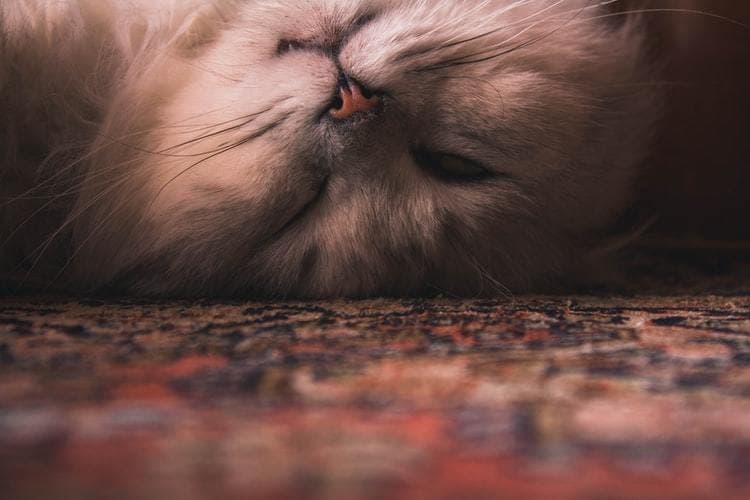Brachycephaly in cats is a trait of skull bones shortened in length, giving the face and nose of a cat a "pushed in" appearance. Due to shorter bones of the face and nose, the anatomy of the face is altered. This can potentially cause various physical problems, such as breathing difficulties.
A condition that is related to this abnormality is brachycephaly airway syndrome. This is a set of airway abnormalities in cats (and dogs) which may involve stenotic nares, elongated soft palate, hypoplastic trachea and everted laryngeal saccules. Typical brachycephalic cat breeds are Persian, Himalayan and Burmese cats.

Brachycephaly in cats
Background information
Brachycephaly is a scientific term for "flat faces", a trait commonly observed among some feline and canine breeds. It is caused by shortened skull bones in lengths and it has been linked to particular health difficulties in both pets. This trait is commonly observed among the Persian and related breeds and it is an inherited trait.
The genetic basis is clear and the characteristic is successfully selected for in several cat breeds. However, the genes associated with it have not been found yet. Although potentially harmful for the animal's health, both cats and dogs with flat faces are still continuously bred for their "desirable" trait. Famous canine breeds who carry this trait are Pugs, English Bulldogs and French Bulldogs.
Symptoms and diagnosis of brachycephaly
Brachycephaly is easily recognizable as a reduction in the face and skull length and a more rounded head (Künzel et al, 2003). The health difficulties a brachycephalic cat may experience are directly dependent on the extent of their brachycephaly. Schlueter et al (2009) recognized four brachycephalic head shapes in cats according to the severity of the deformity: Category I – mild; Category II – moderate; Category III - profound; and category IV – extreme.
The shorter their skull is, the more difficulties the cat may encounter. This is because, although their skull is shorter, it still needs to fit all the tissues as a cat with a normal-sized skull. This can lead to health complications such as difficulty breathing, dental issues and eye problems. It is also possible for cats to suffer from digestive problems, sleep disorders and temperature control issues. One of the more serious conditions associated with brachycephaly is brachycephalic obstructive airway syndrome (BAOS).

Brachycephaly in cats
Brachycephalic Obstructive Airway Syndrome (BAOS)
Brachycephalic obstructive airway syndrome (BAOS) is a set of upper airway abnormalities associated with brachycephalic cats and dogs. The clinical presentation of BAOS involves breathing difficulties, intolerance of exercise, stress and heat, snoring, gagging, choking, regurgitation and vomiting. BAOS disorder involves a combination of one or more of the following abnormalities: stenotic nares, elongated soft palate, hypoplastic trachea and everted laryngeal saccules.
Stenotic nares refer to the narrowed or pinched nostrils. This makes breathing more difficult and causes snorting and snoring. Simple surgeries are available which help widen the nares and help animals breathe. Soft palate is constitutes the back roof of the mouth. When elongated, as seen in animals suffering from BAOS, it is simply too long for the length of the mouth which is why it blocks the entrance to the trachea.
Trachea, or windpipe, is a tube that connects pharynx and larynx to the lungs. It allows the passage of air. When blocked due to elongated soft palate, the air can't freely pass in and out of trachea. Additionally, BAOS may involve hypoplastic trachea too. This is a trait of reduced trachea size, which also disrupts air passage.
And finally, laryngeal saccules are sometimes observed as everted among affected animals. Laryngeal saccules are masses of soft tissue between vocal folds and the lateral wall of the larynx. Their exact function is actually unknown, but when everted that protrude into the opening of larynx which causes snoring, coughing, nasal congestion and shortness of breath.
The symptoms of BAOS can be milder or more serious, and the prognosis and treatment of BAOS depends accordingly. The symptoms can sometimes worsen with age and environmental conditions (i.e. humid or hot weather).

Brachycephaly in cats
Treatment and prognosis of brachycephaly
Main method of reduction of any problems associated with brachycephaly is avoidance of breeding from animals with abnormal skull shapes. For cats who are already carrying the trait, some aspects of the clinical presentation may be addressed by the vet.
Bibliography:
1. Künzel W, Breit S and Oppel M (2003) Morphometric investigations of breed-specific features in feline skulls and considerations on their functional implications. Anatomia, Histologia, Embryologia 32: 223
2. Schlueter C, Budras K, Lugewid E, Mayrhofer E, Koenig H. Walter A and Oechtering G (2009) Brachycephalic feline noses: CT and anatomical study of the relationship between head conformation and the nasolacrimal drainage system. Journal of Feline Medicine and Surgery 11: 891-900



